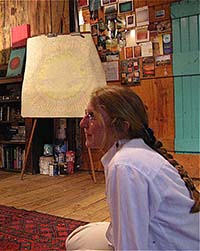Erik Neff
Erik Neff. Painter/and for Our Hills are alive, a Printmaker
Erik has exhibited in galleries and museums in Cleveland, Youngstown, New York and Chicago, including MOCA Cleveland, SPACES gallery, McDunnough Museum, Devening Projects + Editions, Bonfoey Gallery, Raw & Co gallery and Elizabeth Harris Gallery. Erik lives and works in Newbury, Ohio. He grew up in Coshocton Ohio. His work has been shown at the Pomerene Center of the Arts most recently as part of OUR HILLS ARE ALIVE, May/June 2014
As long as I can remember, I have had dual interests in art and nature. I pursued a career in entomology before deciding art was more suited to my temperament. And so for a while I was a perpetual student. I am a practicing artist, specifically an abstract painter. But my interest in insects and nature is a central part of who I am. It informs my painting, but not in any obvious way. I have also done stints as a scientific illustrator from time to time. And so, I was very happy when Anne asked me if I would like to participate in her idea for a show where insects were a partial theme.
I decided to make a series of woodcuts of insects. How to choose what insects to depict? Not wanting to catch and harass insects to serve as models, I went to the trusty Bug Guide dot net hosted by Iowa State University. It is a kind of entomological wiki site where amateurs and professionals can post images of insects they find and begin to classify and identify them. There are some really great images of both common and obscure insects not typically represented in field guides. And so I began to look for insects that caught my eye. I have a particular fondness for tiny flies and parasitic wasps whose bizarre sculptural forms and colors are very nearly a match for their very strange and at times labyrinthine biologies. So those are the sorts of insects that I wanted to depict, partly for their beautiful and interesting forms, but also because of their size, virtually invisible to the naked eye. Some parasitic wasps are indeed tiny, ranging from half a millimeter to maybe 2 to 3 mm and larger of course. This was a chance to give them some exposure that the more popular and well known insects typically enjoy.
Erik Neff April 13, 2014



One Comment
Pingback: